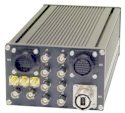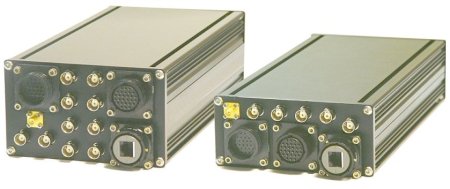Device Profile: Eurotech Rugged DVR platform
Nov 10, 2005 — by LinuxDevices Staff — from the LinuxDevices Archive — 12 views [Updated Nov. 21] — Eurotech is readying a DVR (digital video recorder) platform for trains and other harsh environments. The “Rugged DVR” is based on a passively cooled P133 or Celeron processor, with optional JPEG2000 or MPEG-4 capture/compression, GSM/GPRS (UMTS) radio, gigabit Ethernet, and USB 2.0 ports. It supports Linux and other embedded operating systems.
[Updated Nov. 21] — Eurotech is readying a DVR (digital video recorder) platform for trains and other harsh environments. The “Rugged DVR” is based on a passively cooled P133 or Celeron processor, with optional JPEG2000 or MPEG-4 capture/compression, GSM/GPRS (UMTS) radio, gigabit Ethernet, and USB 2.0 ports. It supports Linux and other embedded operating systems.

The Rugged DVR is available in high- and low-profile enclosures
(Click to enlarge)
According to Eurotech, the device complies with the European Union's EN 50155 standard for railway applications. It also complies with EU standards for humidity, ambient air temperature, storage temperature, vibrations and shocks, power voltage interruption, surges, insulation resistance, and emissions immunity.
The Rugged DVR is can be combined with several other devices from Eurotech to create a complete surveillance system for buses, trains, and other vehicles.

The Rugged DVR is one component of a complete surveillance and/or infotainment system
(Click to enlarge)
The device is designed for easy monitoring and troubleshooting, as well as reliable performance, Eurotech says. Camera interfaces (up to eight BNC connectors) and other field application signal interfaces are located on the rear panel, while troubleshooting and diagnostics interfaces, including I2C, VGA, and keyboard/mouse connectors, are located on the front panel.
What's under the hood?
The Rugged DVR is available with a Pentium 133 or Celeron 400 processor, and between 64MB and 256MB of soldered-down DRAM. The device boots from a solid-state DiskOnChip, and offers three storage options, including internal, external USB, or internal removable hard drives.
An available I2C monitoring system can be used to monitor or extract data from the device even when it is in standby mode or powered down, Eurotech says, to support failure analysis and other forensics. The monitor also offers “pre-alarm” features that can send updates via SMS.
I/O options include fast or gigabit Ethernet, USB 1.1 or 2.0, GSM/GPRS (UMTS), 802.11-b or -g, line- and microphone-level audio I/O, and 12 lines of isolated digital I/O. It also has serial ports, VGA out, miniDIN-6 keyboard and mouse connectors, and I2C port, 6 LEDs, and a reset button.
The device supports DC power inputs from 8.4 to 40V, and draws a maximum of 25 Watts (15 typical). It supports operating temperatures from -25 degrees to 70 degrees Celsius. Available cases measure 10.4 x 5.1 x 2.2 inches (255 x 129 x 57mm) or 10.4 x 5.1 x 3.3 inches (255 x 129 x 83mm). It weighs between 3.3 and 6.6 pounds (1.5 – 3 kg), depending on configuration.
On the software side, the Rugged DVR is available with Linux drivers for a 2.6-series kernel. Under Linux, it supports
- Motion detection
- programmable detection window, motion velocity, and motion sensitivity
- Scalable video output
- Supports ratios such as 1:2, 1:3, 2:3, 1:4
- Programmable video screen position
- JPEG2000 compression
- Elimates blocky, blurry artifacts associated with JPEG
- Supports progressive downloads
- Images can be displayed using common desktop applications
- Broadcast image quality can be tuned to available bandwidth
- Full-resolution images can be stored locally
In addition to Linux, supported operating systems include DOS, Windows XP Embedded, and Windows CE, with QNX available upon request, the company says.
This article was originally published on LinuxDevices.com and has been donated to the open source community by QuinStreet Inc. Please visit LinuxToday.com for up-to-date news and articles about Linux and open source.